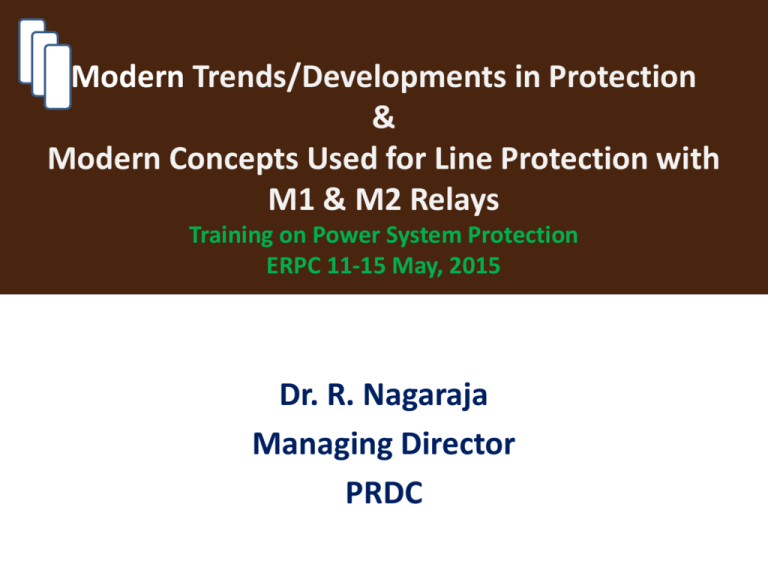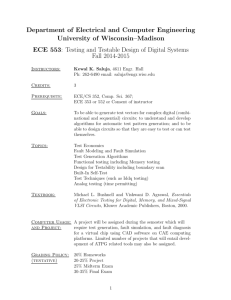Overview of Automated Fault Analysis System
advertisement

Modern Trends/Developments in Protection
&
Modern Concepts Used for Line Protection with
M1 & M2 Relays
Training on Power System Protection
ERPC 11-15 May, 2015
Dr. R. Nagaraja
Managing Director
PRDC
Agenda
Substation and Interface level
Wide Area Protection
Testing Environment
Setting calculation and storage
Disturbance Analysis
Line Protection - Trends
Substation and Interface Level
Substation Level
Substation wiring cost is
being reduced drastically
with IEC 61850
Interoperability between
product and applications
Overall substation
management and efficiency
improvement
Goose messaging is being
used to achieve better
adaptability in setting
Setting and relay operation
waveform upload/download
remotely
Source : ABB Brochure
Optical CT usage has improved the
measurement/sensing and minimized the CT
saturation related errors
Wide Area Measurement and Protection
Distance Protection
F
Zone 3
Zone 2
A
C
B
Zone 1
R
10 Ω
10 Ω
D
5Ω
10 Ω
E
20 Ω
Distance relay zone settings
Zone 1 = 85% of AB = 0.85*10 = 8.5 ohm
Zone 2 = AB+50% of BC (shortest line) =10+0.5*10 =15 ohm
Zone 3 = AB+BC+20% of CD (longest line) = 10+10+0.2*10 =22 ohm
Multi-terminal Lines
A
IA
R
IB
T
10 Ω
10 Ω
Ic
D
B
10 Ω
E
10 Ω
10 Ω
C
VR (I A * Z AT ) (I B * ZTB )
IR
IA
I C
Zone 1 K1 Z AT ZTB ZTB
I A
VR (I A * Z AT ) (I A I C ) * ZTB
IR
IA
I
Zone 2 Z AT ZTB ZTB C K 2 * Z BD
I A
I
VR
ZAT ZTB ZTB C
IR
IA
I
Zone 3 Z AT ZTB ZTB C Z BD K 3 * Z DE
I A
Multi-terminal Lines
Without infeed
( Ic=0)
With infeed
( Ic=IA)
Weak infeed
( Ic=0.5*IA)
Strong infeed
( Ic=2*IA)
Zone 1 (Ω)
17
25.5
21.25
34
Zone 2 (Ω)
25
35
30
45
Zone 3 (Ω)
32
42
37
52
Out of step relay
Traditional relays use zones to determine whether
electromechanical swing will lead to instability or not.
Out of step relay
Large number of simulation need to be carried out to
determine relay settings.
Conventional settings are unsatisfactory and results in
mis-operation because system changes quickly and tested
swings are different from actual.
Adaptive settings are required to cope up with such
problem.
Adaptively changing the timer settings.
Adaptive Zone settings.
New approach is suggested using equal area criteria.
Implemented on Florida-Georgia interface project
undertaken by Virginia Technology.
Out of step relay
E1δ1
Pe1
E 2δ 2
Y12
Pe2
Pm1
Pm2
Y10
M
M1 * M 2
M1 M 2
Pm
Y20
d 2δ
M 2 Pm {Pc Pmax sin( δ γ)}
dt
M 2 Pm1 - M1Pm2
M1 M 2
(M1 M 2 ) tan 12
/ 2
( M1 M 2 )
M 2 E12G11 - M1E 22G 22
Pc
M1 M 2
E1E 2 Y12 M1 M 2 2M1M 2 cos(2θ12 )
2
Pmax
2
(M1 M 2 )
where 1 2 and M1 and M2 are moment of inertia of two rotors
Out of step relay
Equal area criteria
Accelerating area must be smaller than decelerating
area for system to be transient stable.
Back up Protection
Load encroachment
Back up zones of distance relay are prone to tripping
due to load encroachment.
Modification in relay characteristics is required.
Same can be achieved by using phasor measurement
unit.
Back up Protection
A
Assume zone 3 of relay A has picked up.
Determine for any zone 1 fault in other stations using
PMU.
If none of them exist restrain zone 3 of relay since it
might have picked up due to loadability in the system.
Event Analysis and Oscillation Monitoring Schemes using
PMU data
Distance Relay
Concerns
• Parallel line
operation
• Mutual coupling
• In-feed
• Power swing and
load encroachment
Event Analysis and Oscillation Monitoring Schemes using
PMU data
Need
Introduction of PMU has open avenues for various power system
applications
Major challenge is to analyze the group of PMUs and correlate the data with
system events
Utilizing the higher sampling data to analyze more critical system behavior
such as low frequency oscillations
Justification
The scheme focuses on generic architecture for PMU applications.
Event analysis is an important task which can help the data to segregate into
Disturbance data or Ambient data.
Testing Environment
Testing Trend
Steady-state calibration
Dynamic-state simulation
Source: Kinetrics Interoperability Lab
Transient simulation
End-to-end testing.
Use of Real Time Digital Simulation
Environment for special protection systems
(SPS) and critical lines distance scheme
testing is highly recommended
Source: Doble Project at PRDC
Setting Calculations & Storage
Protection Suite Components
Protection
Database
Management
System
Bus-Branch Model
to
Bus-Breaker Model
Protection Setting
Calculation Engine
Protection Suite Components
Special Protection Systems (SPS)
It is not easy to achieve Grid Collapse!!!
Grid Disturbance
Specific Action following an
outage/disturbance
Fast acting and generally without any
time delay
Applicable for tie lines tripping,
HVDC link tripping, major generation
tripping
Saves the system from complete
collapse
Protection Layer
Best Operational
Practices
System
Planning
22
SPS Implementation - Types
Hard wired scheme
Intelligent System
• On tripping of a specific
element/breaker other
elements are tripped to
get load/generation relief
• Generally ends up in more
load shedding or
generation curtailment
• Optimal action is not
ensured
• At times may not get any
relief
• Ensures optimal
load/generation tripping
• Needs system digital and
analog information
• Network topology
processing program
• Dynamically computes the
load or generation to be
tripped for any breaker
tripping
23
Simulation Environment
Improves the protection settings
Simulates various operating conditions
Helps to re-construct and perform postmortem analysis
Design of out-of-step and under frequency
load shedding schemes
Disturbance Analysis
Automation in Fault Disturbance Data
Collection and Analysis
AFAS
Data Collector
Report
Manager
Processed File
Storage
Centralized Deployment of Fault Analysis
System
DPR, DFR,
SCADA ...
Inputs from all locations
Server with Database
and Engines
Queries from Users
Outputs
Levels of analysis
Station
2
Station Level
Station
3
Bay Level
Station
4
Unit Level
Station 1
System Level
Protection
Function
level
Probable Architecture of Fault Analysis System
Fault Analysis System Modules
System Manager
User Access Manager
Configuration Manager
COMTRADE Viewer
Engine
Loggers
Report Generator
Web Interface
Offline Analysis
COMTRADE Viewer
Distance Relay Contour
Case study of AFAS
Waveform of Phase R Current
Inferences
Single line ground fault detected
Fault distance of 286.54 km
Successful auto reclosure having dead time of 1.09 s
CT saturated during fault
CVT is healthy
Relay operation within limits
Power Research and Development Consultants Pvt. Ltd.
Additional Benefits of AFAS
System
Performance
over the
period and
KPI tracking
Algorithm level improvement
Improved Technique for Fault location computation
and identifying cause of Fault
Need of improved scheme
Digital filters are used to compute fundamental component of voltages and
currents.
Discrete Fourier transform (DFT) is a popular filtering technique.
The response time of DFT is around one cycle, which is bound to increase if
the input is non sinusoidal.
Power system computation can have errors due to variation in filter output.
Information about the cause of fault can render assistance to power system
engineers which is not been focused presently
Justification
Scheme based on Prony analysis is effective for short duration fault
Prony analysis determines the components at actual system frequency unlike
DFT which always computes at fixed nominal frequency
Algorithm to identify cause of fault will be an additional information to the
system operators and maintenance crew for taking better decisions.
36
Short Duration Fault
Short duration faults are defined as the faults that are cleared
within two power frequency cycles.
If the faults are cleared fast, the current may not reach its faulted
steady state value and the voltage may not drop to its faulted
steady-state value.
37
Case Study
For 2 bus system, SLG fault is simulated at 95km and 0.1s.
Fault location is computed as:
Im refers to imaginary part of the quantity
V is phase voltage for the faulted phase ‘x’
I is line current for the faulted phase ‘x’
I0 is the zero sequence current
k0 is zero sequence compensation factor
Z1 is positive sequence impedance of line
Fault Location
Fault Location from DFT (km)
Fault clearing
duration
Reported
Minimum
Maximum
Variation
1 Cycle (0.02s)
92.41
-1427.22
4358.57
5785.79
2 Cycle (0.04s)
93.61
86.05
103.44
17.39
3 Cycle (0.06s)
94.22
89.16
100.12
10.96
4 Cycle (0.08s)
94.54
91.23
98.14
6.91
5 Cycle (0.10s)
94.71
92.58
96.93
4.35
6 Cycle (0.12s)
94.81
93.45
96.19
2.74
50 Cycle (1.00s)
94.96
94.96
94.96
0.00
Observations:
1) Fault location value is dependent on fault clearing time.
2) Higher the fault clearing time, more accurate is fault location value.
New Scheme
Start
Consider voltage & current data for fault
period and System frequency
Compute modes using Prony analysis
Any mode with
frequency
variation of +/-5%
from nominal
value?
No
Yes
Compute Fault location
for the identified mode
Stop
Fault clearing duration
Fault Location (km)
1 Cycle (0.02s)
94.86
2 Cycle (0.04s)
94.94
3 Cycle (0.06s)
94.95
50 Cycle (1.00s)
94.95
Observations:
1) Fault location is almost
constant for different fault
clearing time
2) The value obtained are
very near to expected value
of 95 km
Fault Signature
Insulator failure
Tree encroachment
Fault Signature
Lightning strike
Proposed logic
Signature Correlation function
Correlation function can be used to determine fault initiation time and fault
classification
Pre-fault data of faulted phase can be analyzed for small excursions as
Logic to identify rise in current
Parameters
Case-1
Case-2
Imax1 (kA)
4.94
8.89
Imax2 (kA)
8.61
7.67
Imax3 (kA)
8.67
6.88
Imax1 < Imax2
Satisfied
Not satisfied
Imax2 < Imax3
Not checked
Not satisfied
Cause of fault
Tree encroachment
Lightning strike
Cable protection trend
No auto-reclosure for cable fault
400 kV line protection trend
Discussions
Thank You






